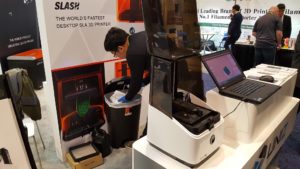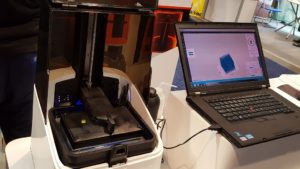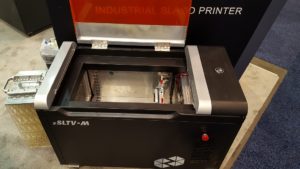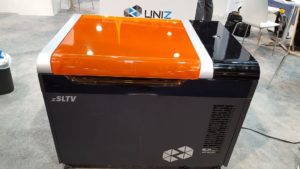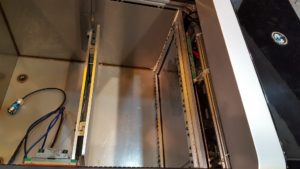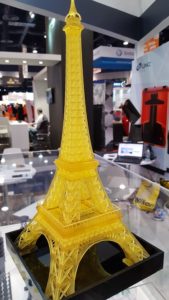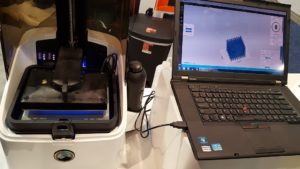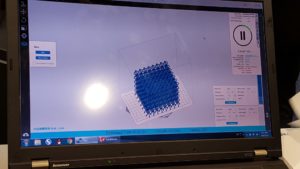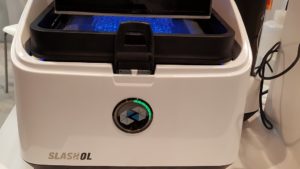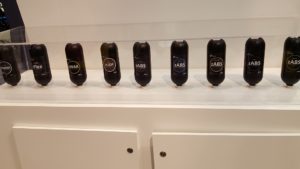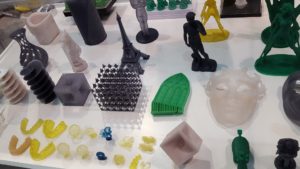
 Two years ago, San Diego-based UNIZ Technology burst onto the 3D printing scene, touting a high-speed stereolithography (SLA) 3D printer, the SLASH. Introduced at CES 2016, the company’s first 3D printer came to Kickstarter that March in what would be a wildly popular crowdfunding campaign. Fast printing speeds and a relatively affordable price tag — starting on Kickstarter at $999 with a final MSRP of $2,000 — quickly drew backers’ attention as the campaign drew in 400%, then 500%, and ultimately more than 1,100% of their initial $50,000 funding goal. Having pulled in $571,926 in funding, UNIZ followed through with a product that not only propelled the company forward, but was delivered to customers and has seen growing use. Two years after the first product introduction, UNIZ is back at CES this week with an impressive five new SLA 3D printers along with a new technology. I had the opportunity to meet with the team at the company’s booth — #9110 in the 3D Printing Marketplace in the North Hall of the LVCC — to learn more about the new introductions and see them in action.
Two years ago, San Diego-based UNIZ Technology burst onto the 3D printing scene, touting a high-speed stereolithography (SLA) 3D printer, the SLASH. Introduced at CES 2016, the company’s first 3D printer came to Kickstarter that March in what would be a wildly popular crowdfunding campaign. Fast printing speeds and a relatively affordable price tag — starting on Kickstarter at $999 with a final MSRP of $2,000 — quickly drew backers’ attention as the campaign drew in 400%, then 500%, and ultimately more than 1,100% of their initial $50,000 funding goal. Having pulled in $571,926 in funding, UNIZ followed through with a product that not only propelled the company forward, but was delivered to customers and has seen growing use. Two years after the first product introduction, UNIZ is back at CES this week with an impressive five new SLA 3D printers along with a new technology. I had the opportunity to meet with the team at the company’s booth — #9110 in the 3D Printing Marketplace in the North Hall of the LVCC — to learn more about the new introductions and see them in action.
“CES is the most important show for us every year. This is our third year, and we have new technology and new materials,” Tao Zhang, Business Development, UNIZ, told me.
“In 2016, we launched our first-generation product, the SLASH. It provides very good speed, accuracy, and reliability, and has had a very good reception. Then we received more requirements and designed for those. We have five new models now, and four are launched on Kickstarter.”
The new 3D printers, live both at CES and on Kickstarter, are again proving to be a big draw. As of my interview with the UNIZ team at 2.30pm on Tuesday, the Kickstarter campaign had been live for about five and a half hours — and had already blown past its $30,000 goal and raked in $70,242 in pledges from 120 backers; as of the time of writing, the campaign is closing in on $125,000 in pledges. In a time of generally dwindling trust for 3D printers on Kickstarter, these numbers are testament to the trust backers have in UNIZ to deliver again. Further building trust is the company’s willingness to show their new line in action, with 3D printers running at their booth at CES.
I watched part of a SLASH OL demo in real time; the green circle on the unit’s front indicates print progression:
The company showcases a time-lapse of a full SLASH OL print job:
The new 3D printer lineup includes:
- SLASH OL — With OL standing for online, this LCD SLA 3D printer is designed for beginners, with demos running live all day at CES.
- SLASH Pro — Targeted toward shoe manufacture, the taller version of the Slash can fit an adult shoe shape.
- SLASH+ — This upgraded version of the original SLASH 3D printer is more stable, with better accuracy.
- The zSLTV-M and zSLTV — These two industrial SLA 3D printers feature larger build volumes and a horizontal orientation. The smaller of the two, the zSLTV-M (M for mini) has a 315 x 180 x 412 mm build volume and is available via Kickstarter; the larger zSLTV, with a 521 x 293 x 651 mm build volume, is a newer devleopment without a firm price yet.
The new machines feature a new 3D printing technology from UNIZ, as the company introduces Uni-Drectional Peel (UDP) 3D printing technology. The company states that UDP allows for the fastest SLA 3D printing performance. Company CEO Dr. Houmin Li explains:
“Uni-Directional Peel (UDP) results from over 2 years’ of dedicated effort by the UNIZ R&D team. By reducing the up-and-down peel to one-directional peel action and using conventional materials, RI-matched cooling, improved light-engine, evolved resin formula, UDP pushes SLA printing speed to the physics limit (14800cc/hr envelope speed or 650mm/hr z-axis speed) without the help of pure oxygen or exotic separation material. This is a revolutionary solution provides speeds more than 100x that of conventional desktop 3D printing technologies such as FDM and laser-SLA.”
In addition to offering UDP in the new lineup, UNIZ is making available both a retrofit kit and a UDP swap for existing SLASH owners to upgrade their 3D printers to incorporate the new technology as a full-spec SLASH+ or SLASH Pro.
The development of UDP technology and work in creating new 3D printers led the company to examine capabilities and speed.
“To further explore the physics limit of 3D printing and scale-up the UDP technology, we designed zSLTV series industrial 3D printers. zSLTV is equipped with the world’s first side-exposure-UDP (se-UDP) technology. The key idea behind se-UDP is that any material has a limit of specific-strength, which means a material will eventually break by gravity when it is long enough. The as-printed photopolymer resin unfortunately has quite low specific-strength and posing a low limit on the longest structure that can possibly be printed using top-down approach. In order to counter the gravity induced break limit, we implemented the submerged side-exposure design using floatation force of the uncured resin to defy gravity on the printed parts, thus enabling reliable and accurate printing of ultra large structures at UDP speed which is over 700x faster than conventional FDM and laser-SLA technologies,” Dr. Li explained.
“Next, we developed refractive index matched cooling tech, which is a key technology UNIZ patented to achieve UDP speed. As described in our previous campaign, to print at super-fast speed, the extensive amount of heat generated during exposure must be removed via convection. However, the cooling structure design and coolant of choice must not affect printing quality. So UNIZ implemented a refractive index matched cooling system in which the cooling channels and coolant are electromagnetically uniform to the excitation wavelength, thus artifacts caused by the cooling system are greatly minimized.”
The team noted a great deal of interest at their booth at CES, as visitors inquired about the capabilities of UDP. As Zhang told me, people have been drawn in because UDP allows for “the fastest 3D printing technology for now — it’s a totally new technology.”
Target industries for the newest introductions from UNIZ include automotive, which can benefit from the large build volumes possible on the industrial 3D printers, as Dong Zhao pointed out, while dental, jewelry, military, aerospace, and prototyping applications can see great use of the speed and resolution from the various machines available. Recent work on precise anatomical models from Hebei University showcases the capabilities of UNIZ technology for accurate, lower-cost medical modelling.
Full technical specs and additional details are available via Kickstarter. The campaign is set to run through February 8th, with shipping slated for July.
Discuss UNIZ, CES, and other 3D printing topics at 3DPrintBoard.com or share your thoughts in the Facebook comments below.
[All photos/video unless otherwise noted: Sarah Goehrke]
Subscribe to Our Email Newsletter
Stay up-to-date on all the latest news from the 3D printing industry and receive information and offers from third party vendors.
Print Services
Upload your 3D Models and get them printed quickly and efficiently.
You May Also Like
Consolidation in AM: How 2025 Is Shaping the Industry’s New Normal
The first half of 2025 has been marked by a clear shift in the additive manufacturing (AM) industry. Companies are no longer just focused on developing new tech by themselves....
Etsy Design Rule Change Reduces Selection of 3D Printed Goods
Online marketplace Etsy has implemented a rule change requiring all 3D printed goods on the site to be original designs. The update to the site’s Creativity Standards states, ¨Items produced using...
U.S. Congress Calls Out 3D Printing in Proposal for Commercial Reserve Manufacturing Network
Last week, the U.S. House of Representatives’ Appropriations Committee moved the FY 2026 defense bill forward to the House floor. Included in the legislation is a $131 million proposal for...
Transforming From Tourist to Native: Duro CEO Michael Corr Explains Why the Company Rebuilt its PLM Software on AI
In these early innings of the AI boom, many market analysts have expressed concern that AI spend has gotten too far ahead of the technology’s proven ability to deliver significant...


